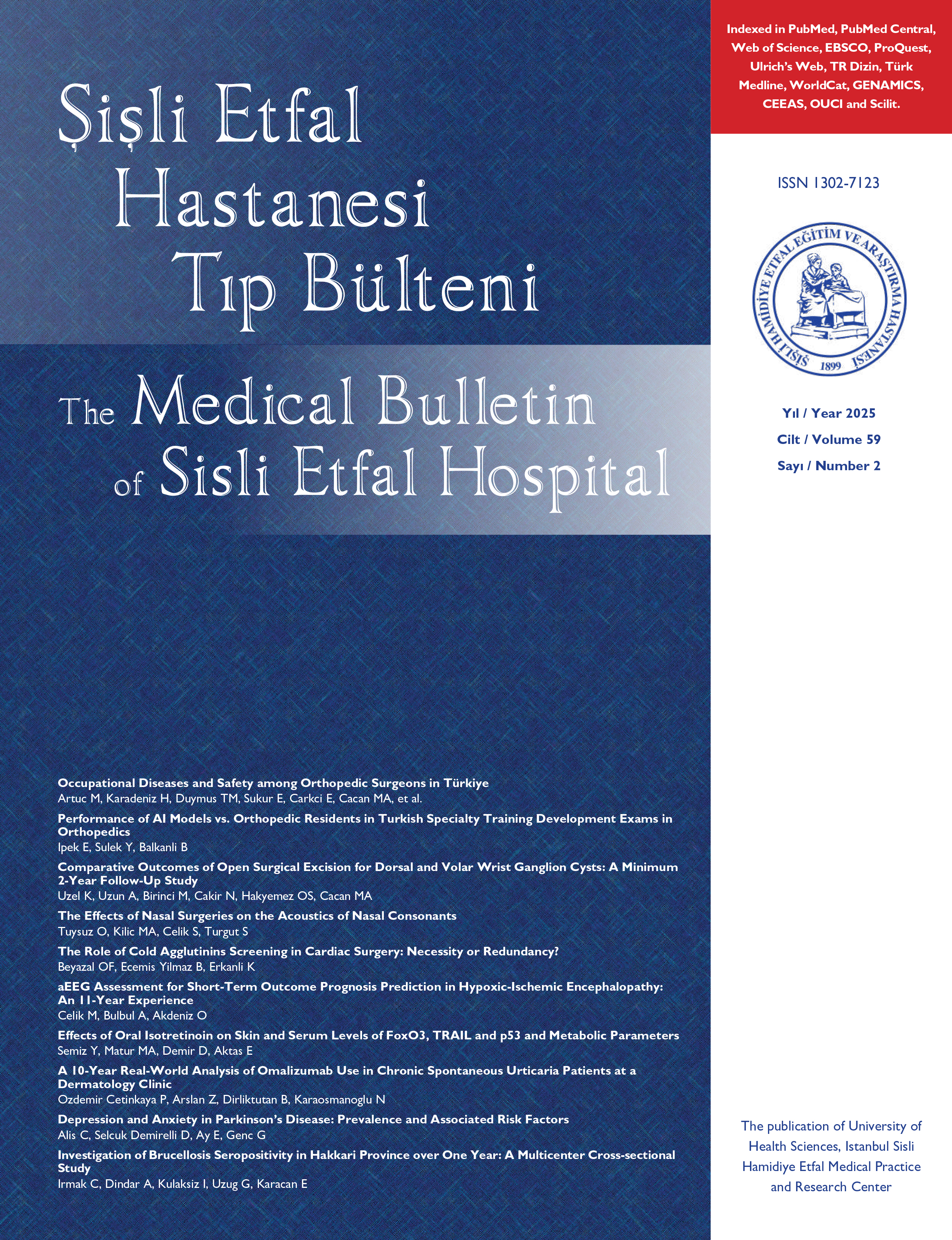
Volume: 32 Issue: 2 - 1998
| ORIGINAL RESEARCH | |
| 1. | Comparison of propofol and propofol combinations in discectomies A. Esin Kalgay Müftüoğlu, Surhan Özer, Sibel Oba Pages 39 - 46 OBJECTTVE: The aim of this study is to investigate the analgesic effect of propofol and propofol combinations, and necessity of its use with opioids. STUDY DESIGN: 30 patients of ASA I and ASA II group undergoing elective lumbar discectomy were included in this study. There groups of 10 patients were chosen. Same anesthesia induction was applied to all patients. Anesthesia maintenance was performed with 15 mg/kg/h propofol (10 min), 6 mg/kg/h propofol (until the end of the operation)and70% N2O+30%02 in GroupI. GroupII was applied same maintenance with an additional initial 0.1 mg fentanil. Group III received initial 0.1 mg fentanil, and 6 mg/kg/h propofol and 70% N2O + 30% 0 2 until the end of the operation. HR, SAP, DAP, MAP, SpO2 and eeCO2 values were measured before induction, after induction, at 5th and 10th mins after intubation and every 10 min then after in all patients. Recovery times were determined. RESULTS: Recovery time was found longer in Group II (p<0.05). Significant increases in eeCO2 values were observed in Group II and III with the recovery of the spontaneous respiration (p<0.05). CONCLUSIONS: Appropriate dose of propofol can provide satisfying analgesia even in painful operations. If necessary, combination of small dose of propofol with opioids may be used; in those cases, postoperative respiratory monitorisation should be taken careffully for an appropriate period. |
| 2. | The effects of operational site and analgesia on postoperative pulmonary functions in abdominal operations Işıl Saylan Birkan Pages 47 - 55 OBJECTIVE: This study is designed to study the effects of the operational site and analgesia on postoperative pulmonary functions in abdominal operations. STUDY DESIGN: Thirty patients for each of cholecystectomy and total abdominal hysterectomy operations, as representatives of upper and lower abdominal operations, are selected randomly for study and control groups. in study group, for early postoperative analgesia, 2 mg/kg hupivacaine hydrochloride was infiltrated subcutaneously through the incision. Pulmonary function tests, arterial blood gas analysis were studied and chest x-ray were taken pre- operatively and on the second postoperative day. RESULTS: in cholecystectomy operations, there were statisticaly significant differences in FVC, FEV 1, FVCA/FVCp, PEF, PaO2, SaO2 and atelectasis among study and control groups, while the differences were nonsignificant in the total abdominal hysterectomy operations. CONCLUSION: in abdominal operations, the site of the operation hasa significant effect on pulmonary functions, while early postoperative analgesia may have an improving effect on deteriorated respiratory functions due to pain. |
| 3. | The effect of propofol-isoflurane and propofol-sevoflurane anestesia on renal function test and recovery characteristics Sibel Oba, Halis Enhoş, Surhan Özer Çınar, Özgür Özbağrıaçık Pages 56 - 60 OBJECTIVE: The aim of this study is to compare the effects of propofol-isoflurane and propofol-sevoflurane anesthesia on renal function and recovery charesteristics in patients undergoing not long lasting surgery. STUDY DESIGN: 29 patients ASA I or II are scheduled not for lasting surgery were involved in this study. The mean surgery time was 90 minutes. Induction anesthesia was the same in both groups hut anesthesia was maintained in the first group (n: 14) with %1-2 isoflurane and in the second (n: 15) with %2-4 sevoflurane + %40 02 and %60 N2O. Serum BUN and creatine levels were determined preoperatively, in first hour per operatively, 1st and 24th hour postoperatively. The recovery characteristics were studied with the following time criteria; the patients spontaneous opening time, answering time to commands, telling his/her name, birth date and the extubation time. RESULTS: This study showed that spontaneous opening time, answering time to commands was significantly (p<0.05) and telling his/her name, birth date time was highly significantly (p<0.00 I) shorter in sevoflurane group. CONCLUSION: in patients undergoing not long lasting surgery sevoflurane anesthesia does not impair renal function and offers clinical advantages (shorter recovery time) over isoflurane anesthesia |
| 4. | Diagnostic value of fine needle aspiration biopsy in head and neck masses Tülay Başak, Canan Tanık, Ayşim Sungun Pages 61 - 66 OBJECTIVE: The differential diagnosis of head and neck masses includes a wide spectrum. in the last 10 years, fine needle aspiration biopsy has heen used widely for the morphological diagnosis of the head and neck masses. in this study diagnostic value of fine needle aspiration biopsy in head and neck masses were investigated. STUDY DESIGN: This study was performed on 60 patients with a mass in the head and neck region. In all the cases, fine needle aspiration biopsy and then excision of the mass were performed. The results of the fine needle aspiration biopsy and paraffin embedded tissue sections were compared. RESULTS: Sensitivity 85%, specificity 100%, Accurancy 93%, positive predictive value 100% and negative predictive value 96%. CONCLUSIONS: Fine needle aspiration biopsy is a quick, economic, well tolerable and safe method, and it can he used as first step to approach the morphological diagnosis of the head and neck masses. |



















